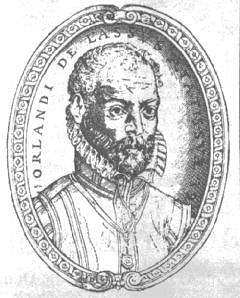Introduction
(born Mons, ?1530 or 1532; died Munich, 14 June 1594).
He served Ferrante Gonzaga of Mantua from circa 1544, accompanying him
to Sicily and Milan (1546-9). He worked for Constantino Castrioto in Naples,
where he probably began to compose, then moved to Rome to join the Archbishop
of Florence's household, becoming maestro di cappella of St. John
Lateran in 1553. After returning north, to Mons and Antwerp, where early
works were published (1555-6), he joined the court chapel of Duke Albrecht
V of Bavaria in Munich as a singer (1556). He married in 1558. Although
a Catholic, he took over the court chapel in 1563 and served the duke and
his heir, Wilhelm V, for over 30 years, until his death. In this post he
consolidated his position by having many works published and travelling
frequently (notably to Vienna and Italy, 1574-9), establishing an international
reputation. The pope made him a Knight of the Golden Spur in 1574.
One of the most prolific and versatile of 16th century composers, Lassus
wrote over 2000 works in almost every current genre, including masses,
motets, psalms, hymns, responsorial Passions and secular pieces in Italian,
French and German. Most of his masses are parody masses based on motets,
chansons or madrigals by himself or others. The large number of Magnificats
is unusual. His motets include didactic pieces, ceremonial works for special
occasions, settings of classical texts (some secular e.g. Prophetiae
Sibyllarum, 1600), liturgical items (offertories, antiphons, psalms,
e.g. Psalmi...poenitentiales, 1584) and private devotional pieces.
He issued five large volumes of sacred music as Patrocinium musices
(1573-6), and after his death his sons assembled another (Magnum opus
musicum, 1604).
Admired in their day for their beauty, technical perfection and rhetorical
power the motets combine the features of several national styles - expressive
Italian melody, elegant French text-setting and solid northern polyphony
- enhanced by Lassus's imaginative responses to the texts. His secular
works reveal a cosmopolitan with varied tastes. The madrigals range from
lightweight villanellas (Matona mia cara) to intensely expressive
sonnets (Occhi, piangete); the chansons include 'patter' songs and
reflective, motetlike works; and among the German lieder are sacred hymns
and psalms, delicate love-songs and raucous drinking-songs. This versatility
and wide expressive range place him among the most signincant figures of
the Renaissance.
Lassus's sons Ferdinand (circa 1560-1609) and Rudolph (circa 1563-1625)
also served the Bavarian court chapel and assembled many of their father's
works for publication. Ferdinand succeeded to his father's post at court;
Rudolph composed much sacred music.
Extracted with permission from
The Grove Concise Dictionary of Music
edited by Stanley Sadie
© Macmillan Press Ltd., London. |
Detailed Information about
-
Picture Gallery
-
List of Works
-
Bibliography
can be found on the internet on:
Classical Music Pages:  |
This project was created by Matt Boynick.
© 1 February 1996
Last Revision - 25 August 1999
|

